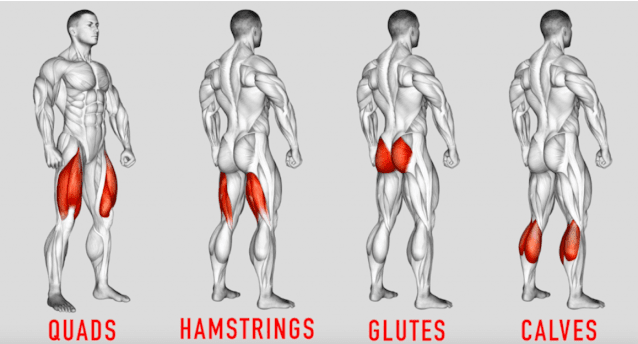Pendulum Squats - What are they and how do I do them?
What are Pendulum Squats?
How do I do Pendulum Squats?
- Load your required resistance plates. Start with a light load and pyramid up for your working sets.
- Stand on the footplate with your feet slightly narrower than shoulder-width and toes pointing slightly outwards. Lean backwards onto the support and bend your legs slightly so that your shoulders fit under the shoulder pads.
- Grab hold of the bar for stability and straighten the legs to release the safety bar. This is your starting position.
- Slowly lower your body by bending the knees over the tops of your toes breathing in as you go.
- Once you have bent your knees to just under 90 degrees, breathe out and press the body upwards in an explosive motion.
- Before your leg fully straightens, start the next repetition.
- Repeat for the required number of reps and sets.
Pendulum Squats Vs Regular Squats
- your knee is at a different angle than it would be with a traditional squat. This means that the quads are hit from a different angle and this will use fibres that might not usually be activated. Hitting the muscles from different angles will assist with hypertrophy and strength gains.
- You can squat with a much heavier load on a pendulum machine than you can with a barbell. This is because you do not have to stabilise the weight with your core or balance a bar on your shoulders. there is no need for a spotter and you do not have to worry about dropping the bar if you are training to complete failure.
- The wide footplate on a pendulum squat machine allows you to use different foot positions in order to hit different sections of the quads, glutes and hamstrings. If you want to develop the hamstrings, you can place the feet at the top of the footplate or for more quad involvement, place them to the side at the bottom of the footplate. This is great if you have areas of your legs that are lagging and need extra tension in the compound movements.
- The swinging motion of the machine allows for a wide range of motion, You can squat really deep if you have the mobility and flexibility. Your hips travel further back than they would with a traditional squat and there is more activation in the knee joint.
- If you are new to squatting, the pendulum machine is a great way to get used to the movement. You can start with a light weight and give yourself a good base strength to start from.
- You can use resistance bands to keep your knees in a rigid position throughout the movement. This helps if you are trying to develop the outer quads as it puts them under more tension.
- It is easier to perform pyramid sets or drop sets on a machine than it is with a barbell and weight plates. Especially if you have somebody to assist.
Pendulum Squats Vs Hack squats
Muscles Worked With Pendulum Squats
Alternatives to Pendulum Squats
Where Can I Buy a Pendulum Squat Machine?
Conclusion
Pendulum squat FAQs
1. What is a pendulum squat? The pendulum squat is an innovative and effective lower body exercise that targets the quadriceps, hamstrings, glutes, and lower back. The unique movement, mimicking a pendulum, allows for better weight distribution and range of motion, putting less stress on the knees and lower back. 2. What makes pendulum squats different from traditional squats? The key difference lies in the weight distribution and the movement pattern. In a pendulum squat, the weight is placed horizontally along a curved track, while in a traditional squat, the weight is typically placed vertically on the shoulders. This horizontal placement helps reduce stress on the knees and lower back while still providing a challenging workout for the legs. 3. Can beginners perform the pendulum squat? Absolutely! Pendulum squats are suitable for both beginners and experienced fitness enthusiasts. Beginners can start with lighter weights and gradually increase resistance as they become comfortable with the exercise. 4. How do I perform a correct pendulum squat? Stand with your feet shoulder-width apart, facing the machine. Hold the handles and position yourself under the shoulder pads. Lower your body by bending your knees and hips, keeping your chest up and core engaged. Push through your heels to return to the starting position. Ensure your knees do not cave in and maintain control throughout the movement. 5. How many sets and reps should I do? The ideal number of sets and reps depends on your fitness goals. For building strength, aim for 3-5 sets of 4-6 reps. For muscle hypertrophy, 3-4 sets of 8-12 reps are ideal. For general conditioning and muscular endurance, 2-3 sets of 12-15 reps work best. 6. Are there any variations to the pendulum squat? Yes, there are several variations to this exercise. You can perform the pendulum squat with a wide stance, narrow stance, or even add a pause at the bottom of the squat to increase difficulty and target different muscle groups. 7. What muscles does the pendulum squat work? The pendulum squat primarily targets the quadriceps, hamstrings, and glutes. However, it also engages the lower back, calves, and core muscles to maintain proper form and posture. 8. Is the pendulum squat safe for individuals with knee or lower back issues? While this exercise is generally safer for the knees and lower back than traditional squats, it's crucial to consult with a medical professional before incorporating any new exercise into your routine, especially if you have pre-existing conditions or concerns.





.png)



